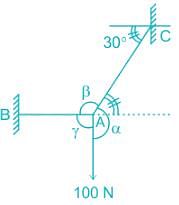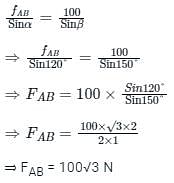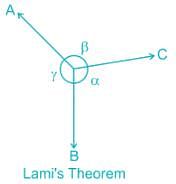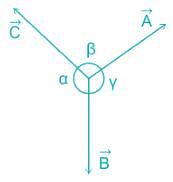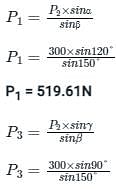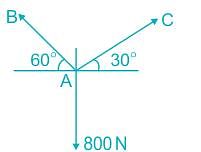Test: Lami's Theorem - Civil Engineering (CE) MCQ
10 Questions MCQ Test Engineering Mechanics - Test: Lami's Theorem
| 1 Crore+ students have signed up on EduRev. Have you? Download the App |
A string whose extreme A is fixed has weights W1 and W2 attached to it at B and C, respectively, and passes around a smooth peg D carrying a weight of 730 N at the free end E. If in a state of equilibrium, BC is horizontal and AB and CD make angles of 135° and 110°, respectively, with BC, the weights W1 and W2 will be ______ and ______, respectively.


A body acted upon by three coplanar forces P1, P2 and P3 (as shown in figure) is in equilibrium. Which of the following is correct? [where, "O" is the point of concurrency of the forces]

If point A is in equilibrium under the action of the applied forces, the values of tension. TAC = ?

According to Lami’s theorem, if three coplanar forces are acting at a point b in equilibrium, then each force is proportional to the ______ of the angle between the other two.
Three coplanar forces A, B and C acting at a point in the plane are in equilibrium. If the given value of A is 1.9318 kg wt and sinθ1 is 0.9659, what is the value of C?
If three forces, acting at a point, be in equilibrium then each force is proportional to the sine of the angle between the other two. This theorem is called
What is the minimum number of non-zero vectors in different planes that can be added to give a resultant of zero?
If the body is under equilibrium under the influence of a set of non-colinear force, then the minimum number of forces has to be
|
24 videos|59 docs|53 tests
|
|
24 videos|59 docs|53 tests
|





